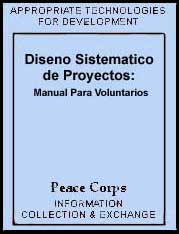 Diseno
sistematico de proyectos
Diseno
sistematico de proyectosManual para voluntarios
 Diseno
sistematico de proyectos
Diseno
sistematico de proyectos
Manual para voluntarios
Peace Corps
Information Collection and Exchange
R-44 B
September 1982
Reprinted with permission from Center for Educational Development in Health for Peace Corps use only.
Fourth Edition
September 1980
Copyright by
Center for Educational Development in Health
Boston University, 1980
INFORMATION COLLECTION & EXCHANGE
Peace Corps' Information Collection & Exchange (ICE) was established so that the strategies and technologies developed by Peace Corps Volunteers, their co-workers, and their counterparts could be made available to the wide range of development organizations and individual workers who might find them useful. Training guides, curricula, lesson plans, project reports, manuals and other Peace Corps-generated materials developed in the field are collected and reviewed. Some are reprinted "as is"; others provide a source of field based information for the production of manuals or for research in particular program areas. Materials that you submit to the Information Collection & Exchange thus become part of the Peace Corps' larger contribution to development.
Information about ICE publications and services is available through:
Peace Corps
Information Collection & Exchange
1111 - 20th Street, NW
Washington, DC 20526
USA
Website: http://www.peacecorps.gov
Telephone : 1-202-692-2640
Fax : 1-202- 692-2641
Add your experience to the ICE Resource Center. Send materials that you've prepared so that we can share them with others working in the development field. Your technical insights serve as the basis for the generation of ICE manuals, reprints and resource packets, and also ensure that ICE is providing the most updated, innovative problem-solving techniques and information available to you and your fellow development workers. |
Introducción: Proceso para la planificación, ejecución y evaluación de proyectos
Primer capitulo: Análisis de las circunstancias (situaciones)
Segundo capitulo: Identificación de las necesidades determinación de las necesidades y deseos de la comunidad
Tercer capitulo: Planificación y ejecución de las labores
Cuarto capitulo: Evaluación del avance y resultado del proyecto
Capitulo quinto: Solución de los problemas
Sexto capítulo: Seguimiento y evaluación del impacto del proyecto
Métodos para obtener información
Investigación bibliográfica
Investigación sobre el terreno
Consultas a expertos; juntas de especialistas; conferencias técnicasMétodos para la planificación y realización de proyectos
Organización comunitaria
Discusiones en grupo
Ofreciendo un modelo de conducta
Educación no formal; entrenamiento practico en el trabajo
Asistencia técnica, entrenamiento, formación de equipos de lideres
Análisis de costoRetroalimentación
Pruebas practicas
Presentación de estadísticas e infomaticion cualitativa
Tercera parte: Manuales o guías de instrucción
1.00 Salud y atención medica fundamental
2.00 El agua y su purificación
3.00 La nutrición y producción de alimentos
4.00 Educación
5.00 Desarrollo económico
6.00 Servicios comunitarios
7.00 Fuentes de energía y su preservación
8.00 Varios